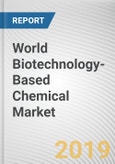The global biotechnology-based chemical market is segmented on the basis of end users, applications, and geography. End users for biotechnology-based chemical market consist of bio-pharma, agri-biotech, bio-informatics, bio-services. Further, application market comprises of food and beverages, agriculture, fuel, energy, animal feed, pharmaceuticals and nutrition, paper and pulp, cosmetics and toiletries, and plastics and fibres. Geographically, the market is segmented as North America, Asia-Pacific, Europe, and LAMEA.
Biotechnology-based chemical market is fragmented and few of the key players include Queensland’s world-class agriculture industry, Sarnia-Lambton Research, UK and Norway business funding agencies, the Technology Strategy Board (TSB) and Innovation Norway.
KEY BENEFITS:
This study provides an in-depth analysis of the biotechnology-based chemical market with current and future trends to elucidate the imminent investment pockets in the market.
This report also provides information regarding key drivers, restraints, and opportunities with impact analysis.
Quantitative analysis of the current market and estimations through 2014-2020 are provided in this report to showcase the financial caliber of the market.
Porter’s Five Forces model of the industry illustrates the potency of the buyers and suppliers participating in the market.
SWOT analysis highlights the internal environment of leading companies for effective strategy formulation.
Value chain analysis in the report provides a clear understanding of the roles of stakeholders involved in the value chain
MARKET SEGMENTATION:
The market is segmented on the basis of end users, application, and geography
MARKET BY END USERS:
Bio-pharma
Agri-biotech
Bio-informatics and
Bio-services
Others
MARKET BY APPLICATIONS:
Food and beverages
Agriculture
Fuel
Energy
Animal feed
Pharmaceuticals and nutrition
Paper and pulp
Cosmetics and toiletries
Plastics and fibres
Others
MARKET BY GEOGRAPHY
North America
Asia-Pacific
Europe
LAMEA
Methodology
The analyst offers exhaustive research and analysis based on a wide variety of factual inputs, which largely include interviews with industry participants, reliable statistics, and regional intelligence. The in-house industry experts play an instrumental role in designing analytic tools and models, tailored to the requirements of a particular industry segment. The primary research efforts include reaching out participants through mail, tele-conversations, referrals, professional networks, and face-to-face interactions.
They are also in professional corporate relations with various companies that allow them greater flexibility for reaching out to industry participants and commentators for interviews and discussions.
They also refer to a broad array of industry sources for their secondary research, which typically include; however, not limited to:
- Company SEC filings, annual reports, company websites, broker & financial reports, and investor presentations for competitive scenario and shape of the industry
- Scientific and technical writings for product information and related preemptions
- Regional government and statistical databases for macro analysis
- Authentic news articles and other related releases for market evaluation
- Internal and external proprietary databases, key market indicators, and relevant press releases for market estimates and forecast
Furthermore, the accuracy of the data will be analyzed and validated by conducting additional primaries with various industry experts and KOLs. They also provide robust post-sales support to clients.

LOADING...








